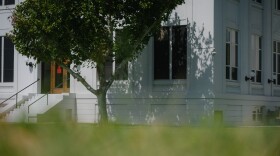The advertising war over the future of the Mission Valley is fully engaged as two redevelopment plans compete for public support.
Measure E and Measure G need voter approval this November if backers of either plan want to move forward with a massive multibillion-dollar makeover of the Mission Valley stadium site.
One traditional battleground in the struggle to win voter support is local television and ads are saturating airwaves.
San Diego State University backers formed SDSU West and wrote an initiative, Measure G, that allows the school to buy 132 acres of the land to build an auxiliary campus.
“Measure G will transform the Mission Valley stadium property into a world-class education and research center with a stadium for football and soccer,” said the SDSU West television ad.
The group of SDSU boosters raised just over $2 million since the beginning of 2017 and the initiatives boosters tout the university’s vision for the site.
School officials engaged an architectural firm, Carrier Johnson, which designed what the multibillion-dollar makeover of the site could end up looking like.
The renderings show housing, offices, commercial space, a stadium and a river park.
“This is the best initiative for the region of San Diego because it will grow the campus in an open and transparent process and it will also grow the economy which means it will benefit the entire area for years and years to come,” said Katy Temple, a spokesperson for SDSU West.
SDSU West secures a home for the Aztecs football team and university officials promise to use public-private partnerships to develop the property so the school will not have to spend public dollars.
At the school’s event unveiling the university’s vision for the site, SDSU’s then-interim president, Sally Roush, said the entire project could be built without using public money.
SoccerCity has an opposing view
The backers of Measure E, have reached a different conclusion.
In one of its campaign ads, U.S. soccer star Landon Donovan, an investor in the SoccerCity project, offers an actor virtual reality glasses.
“Hey, you wanna see the future?” Donovan said.
The glasses show renderings of the SoccerCity vision which includes a sports stadium housing and parkland.
“How much does this cost?” the actor asks Donovan.
“Won’t cost you a dime,” Donovan said.
“Want to see what you get with measure G?” another actor asks.
“Hey, are these broken?” the actor asks as he sees no change in the existing sports stadium and parking lot.
That ad and others are already getting significant airtime.
Measure E’s supporters have raised just over $5 million since the beginning of 2017 to help convince voters their development is the one voters should support.
SoccerCity backers say their measure moves quickly to replace the city’s aging stadium.
“Measure E finally does something with the asset that is burning $6 million a year of the city’s money. It converts it into something that creates hundreds of millions of dollar of value for the city, the county and the schools,” said Nick Stone of FS Investors, the group backing measure E.
FS Investors hope to leverage their multibillion-dollar redevelopment blueprint to lure a Major League Soccer expansion franchise to San Diego.
SoccerCity proposes buying and leasing about 230 acres of city-owned land to build a sports stadium, entertainment district, housing, hotels, commercial space and a river park.
“You’ll see us on TV, again, talking about the fact that Measure E is $200 million better than every other plan out there. And it’s the only plan that’s going to happen quickly, and it doesn’t cost taxpayers a penny, and that should be the key takeaway.
There’s something great for everybody here, and it doesn’t cost anything,” Stone said.
Opponents fight back
That’s not the opinion of two wealthy Mission Valley developers and property owners.
Sudberry Properties and H-G Fenton are both well connected politically and they raised nearly $3.4 million since the beginning of 2017 to pay for media ads blasting SoccerCity.
One ad begins with dramatic music and scenes of traffic-clogged roads.
“The last thing Mission Valley needs is more traffic, but that’s exactly what we’ll get with measure E,” said the announcer.
The two developers both have ties to the SDSU West measure, and they are reaching out to voters with traditional commercial television ads and online ads.
“We want to educate voters. We want to inform them. Because we know that when people find out about what’s inside this so-called SoccerCity measure, that voters run away,” said Laura Fink, a spokeswoman for the group No on SoccerCity.
And there is one more player in the game.
San Diego State University is not legally allowed to promote the SDSU West initiative, but the school says it would love to get access to the Mission Valley stadium site.
The university is paying for commercial television airtime and digital advertising for an image campaign that will compete for attention airtime during this political season.
The ads sport an “I am SDSU” theme featuring the school’s football coach, students and residents with the goal of emphasizing the school’s positive impact on the community.
School officials say it is common for SDSU to run fall public relations campaigns.
The city of San Diego’s registered voters make their decision in early November.
The measure with the most votes over 50 percent would prevail.
It is possible that voters reject both measures, and that would leave the city to figure out the future of the Mission Valley site.






